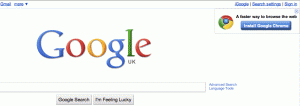Published: September 10th, 2010
We don’t really like to brag about the success we have within the serps for our clients but this one is worth mentioning. I have monitored the SEO skills of a number of large brands for a while now and continue to be unimpressed. Of course there are the likes of ASOS who are very strong within the serps however some of the traditional offline brands seem to struggle.
A great example of this is from some of our own SEO work within the Golf industry. Using the search term ‘Nike Golf clubs’ you will see the following listings and positions:
Published: September 9th, 2010
So as you are probably aware Google’s latest search innovation google instant that gives predictive search results and has been launched to much fanfare today. Google says it will speed up search and get people their results faster. This is done by using an AJAX technique ( technically as it doesn’t use XML but JSON in it’s response I guess it is AJAJ but that doesn’t sound as good) with a HTTP request being sent after every letter you type which returns an updated set of results.
Now from a usability point of view this a great, however it comes at an expense as each of these requests uses up valuable bandwidth. A quick test we performed searching for the term designer shoes, resulted in 11 requests and which totalled just over 100KB in the JSON responses (that doesn’t include extras such as any maps or images that may also be returned for irrelevant predicted results), a search for golf clothing gave 9 requests and 85KB. Now these figures on their own are not massive, but if you take into account the amount of searches done on globally on google everyday (over a billion) and if each of these is resulting in say extra 50KB of internet traffic then that works out at approximately 46 Terabytes of extra traffic on the internet every day*.
So as this new feature is designed to speed up searching, could it have the opposite effect on the rest of internet browsing? It will be interesting to see whether or not all this extra traffic will slow down the rest of the web.
Published: September 8th, 2010
Google’s sea change was announced today in the form of Google Instant, interesting challenges for SEO lie ahead, I’ve tried the new system, in a nut shell it’s fast predictive search, looks at bit messy to be honest, however it’s Google and in time it will feel like second nature. For SEO I don’t think it will make much difference (then again I could be completely wrong here), results are still based on keywords predicted or not. One thing I did notice is the ‘I’m feeling lucky’ tab is far more prominent, not sure how Google judges who should be the lucky ones to receive that traffic. At Blueclaw we’ll play around with Google Instant and report back. What’s your opinion on Google Instant?
Published: September 7th, 2010
There has been quite a buzz today around the net about the new Google Doodle with interactive dots ( if you haven’t seen it yet checkout the Google homepage ). It uses a nice little bit of JavaScript and CSS3 to animate a group of HTML “dots” to form the Google logo and interact with the mouse pointer.
However one person in the Blueclaw office is unable to view this in his browser of choice, Mark one of our designers who like all hippy creative types chooses to use OSX and browses the web using Safari 5. Instead of the much talked about doodle Mark is greeted with an message telling him to install Google Chrome for “A faster way to browse the web”.

Safari on OSX does not show the doodle but an install chrome button
Now seeing as chrome and Safari use a very similar version of the Webkit rendering engine and Safari supports the border-radius CSS property to used to make the dots there seems no reason why the doodle would not work in this browser. On checking the homepage source code on both Safari and Chrome it seems that the JavaScript for the doodle is not served up to OSX Safari at all so some browser detection is done server side and for some reason a decision has been made to serve OSX Safari users a version of the page without the doodle.
But why is this done? Our best guess is that it is a ploy by Google to get more OSX users to install Chrome to be able to
Published: September 3rd, 2010
Before putting together PR campaigns and optimising your press release, it is useful to know who you are going to target and find out where the most influential people may be hiding. News will be picked up by the right people if it is relevant and current so creeping into the right hubs and schmoozing with journalists is always a wise move.

